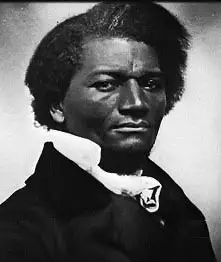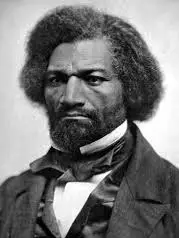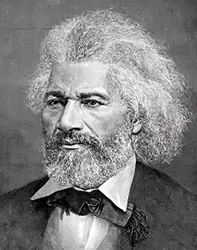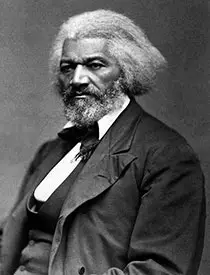Frederick Douglass was the most well-known Black person in America as he bravely fought for the cause of the abolishment of slavery in the United States.
Frederick Augustus Washington Bailey was born in Talbot County, Maryland, on the Eastern Shore of the Chesapeake Bay. He was born a slave, the son of Harriet Bailey and an unknownn white man, presumably his master. His birthdate and year are unknown although he celebrated it on February 14th. He was believed to be of mixed race, with African, European and Native American blood flowing through his veins. As was often the custom in parts of the south, he was separated from his mother at an early age and only had vague memories of her. He was thereafter raised by his maternal grandmother until they too were separated. He was eventually sent to live with Hugh Auld, a ship carpenter, in Baltimore, Maryland.
It was while living with the Aulds that he began to learn, as Hugh’s wife Sophie began to teach him the alphabet. It was against the law in Maryland to teach a slave to read, but Sophie thought it important to teach young Frederick. Hugh, on the other hand, was very much against teaching him to read, believing that if a slave was taught to read and think that it would prompt him to desire his freedom. He thus admonished her not to teach him any further but Frederick, being very bright, paid attention to other children reading as well as his co-workers when he got older.
"Knowledge is the pathway from slavery to freedom."
Frederick continued to educate himself, sneaking to read anything he could get his hands on. As he became more learned, he began to question the institution of slavery, much as Hugh Auld had warned. His main source of inspiration for his thinking was an anthology entitled “The Columbian Orator” which was published in 1797. It contained many essays and speeches and it lit him afire with a passion for learning, philosophy and self-direction.
 Frederick was hired out to William Freeland and spent time among Freeland’s slaves. Frederick decided that he would help the other slaves to learn as had he and began teaching them to read the Bible at a weekly Sunday school service. Much like him, the other slaves became enamored with learning. Weeks later, neighboring plantation owners learned what Frederick was doing and threatened to beat all of the slaves attending the next Sunday school meeting.
Frederick was hired out to William Freeland and spent time among Freeland’s slaves. Frederick decided that he would help the other slaves to learn as had he and began teaching them to read the Bible at a weekly Sunday school service. Much like him, the other slaves became enamored with learning. Weeks later, neighboring plantation owners learned what Frederick was doing and threatened to beat all of the slaves attending the next Sunday school meeting.
In 1933, Frederick returned to Thomas Auld, Hugh’s brother. Thomas had been Frederick’s real owner and he sent him off to work for a farmer named Edward Covey. Covey was well known with a reputation for beating slaves and breaking their wills. Thomas must have wanted to break Frederick’s spirit, so Covey beat the young teenager frequently. While the brutal whippings took their toll on his psychologically, he was a strong young man and eventually fought back against Covey, after which the beatings ceased. Without the care of his mother and grandmother and even Sophie Auld, Frederick developed a deep hatred for his bondage and became determined to escape from it. He first tried to escape from William Freeland and then later from Covey in 1836.
In 1837 he began a relationship with Anna Murray who was from Baltimore, Maryland. She was a free woman of color and was five years older than him. The thought of being a slave married to a free woman was too much for him and he decided to try another escape attempt. On September 3, 1838 he jumped aboard a Philadelphia, Wilmington & Baltimore train headed north and got off in Havre de Grace, Maryland. Rather than continue on the train which would have taken him to Pennsylvania, a free state, he got off in Havre de Grace and ventured across Delaware, another slave state. The journey across Delaware was very short and using a sailor’s uniform and money provided by Anna and identification papers that he obtained from a free Black seaman, he rode a steam-ferry to Perryville, Maryland and then a train to Wilmington, Delaware. He then caught a steamboat across the Delaware River until he finally reached Philadelphia, Pennsylvania, one of the most stridently anti-slavery states in the country. He continued on until he reached the safe house of abolitionist David Ruggles in New York City. The nerve-racking trip took just under 24 hours and he rejoiced about gaining his freedom”
"I have often been asked, how I felt when first I found myself on free soil. And my readers may share the same curiosity. There is scarcely anything in my experience about which I could not give a more satisfactory answer. A new world had opened upon me. If life is more than breath, and the ‘quick round of blood,’ I lived more in one day than in a year of my slave life. It was a time of joyous excitement which words can but tamely describe. In a letter written to a friend soon after reaching New York, I said: ‘I felt as one might feel upon escape from a den of hungry lions.’ Anguish and grief, like darkness and rain, may be depicted; but gladness and joy, like the rainbow, defy the skill of pen or pencil."
As soon as he was able to, he sent for Anna and she joined him in New York where they were married on September 15, 1838, less than two weeks after his escape. They initially took the name Johnson but adopted the last name Douglass after they moved to New Bedford, Massachusetts, which had a thriving free black community. The couple would eventually have five children, three boys and two girls. The couple joined the African Methodist Episcopal Zion Church and Frederick became a licensed minister in 1839. This would begin his times as a public speaker and in 1840 he gave a speech in Elmira, New York, one of the stops on the Underground Railroad.
 Douglass became a staunch abolitionist and joined several anti-slavery organizations and subscribed to “The Liberator,” the weekly journal authored by abolitionist William Lloyd Garrison. Douglass was so taken with Garrison’s words that he later stated that “his paper (The Liberator) took a place in my heart second only to the Bible.” Garrison was likewise impressed with Douglass, and he wrote about him in the Liberator and soon the two began speaking at anti-slavery meetings in New York and Massachusetts. Douglass, though only 23 years of age, was invited to speak about his time as a slave in front to the Massachusetts Anti-Slavery Society’s annual convention in Nantucket, Massachusetts.
Douglass became a staunch abolitionist and joined several anti-slavery organizations and subscribed to “The Liberator,” the weekly journal authored by abolitionist William Lloyd Garrison. Douglass was so taken with Garrison’s words that he later stated that “his paper (The Liberator) took a place in my heart second only to the Bible.” Garrison was likewise impressed with Douglass, and he wrote about him in the Liberator and soon the two began speaking at anti-slavery meetings in New York and Massachusetts. Douglass, though only 23 years of age, was invited to speak about his time as a slave in front to the Massachusetts Anti-Slavery Society’s annual convention in Nantucket, Massachusetts.
In 1843, Douglass embarked upon a six month tour along with other speakers as part of the American Anti-Slavery Society’s “Hundred Conversion” project. The tours traveled throughout the Midwest and the Northeast, drawing attention to the plight of those held in captivity. For abolitionist speakers, the reception was often hostile. For Douglass, it almost cost him his life as he was often confronted violently and once suffered a broken hand when he was attacked by an angry mob in Pendleton, Indiana. He was rescued by a local Quaker family, but his hand never fully healed properly, though it did not slow him down.
In 1845, Douglass decided to publish his autobiography in order to give an account of his years in subjugation to a wider audience. The book was entitled “Narrative of the Life of Frederick Douglass, an American Slave.” The book became a best seller though critics and skeptics insisted that it must have been ghost-written, arguing that a Black person could not have written so eloquently.
As Douglass became more well-known, his confidantes feared that his growing stature and notoriety might draw the attention of his owners Thomas and Hugh Auld, who might try to bring him back into captivity. They convinced him to help to drum up support for the abolitionist movement outside of the United States. He traveled to Ireland and Britain, speaking in places of worship for more than two years. During his travels he met with many abolitionists and some of his supporters in Britain, led by Ellen Richardson, got together and purchased his freedom from Thomas Auld. Though he was coaxed to continue on with his work in Britain, he returned to the United States in the spring of 1847.
Upon his return to the United States, Douglass decided to follow in the path of William Lloyd Garrison and became a newspaper publisher. His newspaper, “the North Star” was produced in the basement of the AME Zion Church in Rochester, New York, and carried with it the banner “Right is of no Sex – Truth is of no Color – God is the Father of us all, and we are all brethren.” Having gained a greater voice, Douglass soon came into conflict with other abolitionist groups. He denounced the American Colonization Society which advocated freeing the slaves and sending them back to Africa and he even came into conflict with Garrison, whom he considered too radical. Garrison believed that the United States Constitution was a pro-slavery document because it counted Black slaves as only 3/5 of a person for voting representational purposes and because many compromises were negotiated into it which allowed slavery to continue. Douglass, on the other hand was convinced that the Constitution laid the groundwork for ending slavery.
In 1848, Frederick attended the Seneca Falls Convention in New York, the only Black person attending. When a motion was made by Elizabeth Cady Stanton to pass a resolution to ask for women’s suffrage, Douglass announced that he was in favor of such a resolution, stating that it would not be fair for him to vote as a Black man if women were not also provided the same right.
"In this denial of the right to participate in government, not merely the degradation of woman and the perpetuation of a great injustice happens, but the maiming and repudiation of one-half of the moral and intellectual power of the government of the world. "
The resolution was thereafter passed. He continued to press for the rights of women, both in speaking engagements and in the North Star. He backed away, somewhat later, when women’s right advocates sought to press the cause of Blacks and women together in regard to the impending passage of the 15th Amendment which proposed to give Black men the right to vote. Douglass feared that including women in the discussions could derail and fracture the narrow support for the amendment.
Douglass merged his North Star newspaper with Gerrit Smith’s “Liberty Party Paper” in 1851 and the new entity was called “Frederick Douglass’ Paper” which would run for another nine years and in 1855, Douglass published another autobiography entitled “My Bondage and My Freedom.”
Despite his thoughts on the 15th Amendment, Frederick continued to speak out in favor of the rights of women and the rights of Blacks. His speech before the Rochester Anti-Slavery Sewing Society is remembered by many as one of his greatest speeches. He advocated the desegregation of educational facilities, arguing that education was one of the most fundamental needs of the Black community and that the disparity between white schools and Black schools created a roadblock.
At around this time in the autumn of 1859, Douglass was approached by John Brown, the virulent abolitionist. Brown devised a plan to raid the Federal armory in Harpers Ferry, West Virginia and to distribute the weapons therein to slaves and abolitionists across the country. His plan to overthrow the slave south was too risky for Douglass, who believed the attack on federal property would turn the American public against the abolitionist movement. The raid was unsuccessful and Frederick felt that by guilt through association, his safety might be at risk and he fled to Canada. A year later, while he was traveling in England, Douglass was informed that his youngest daughter Annie had passed away in Rochester. He traveled back to attend to her services.
Upon the beginning of the American Civil War, Douglass advocated on behalf of Blacks wanting to fight in a war for their freedom. He spoke publicly and through print on this issue and was invited by President Abraham Lincoln to sit down and discuss the matter. It could be argued that having the ear of the President made Douglass the most powerful Black man in the country. He talked to Lincoln about the role and the treatment of the Black soldier and later spoke with Andrew Johnson about Black voting rights.
When President Lincoln announced the Emancipation Proclamation, it freed the slaves being held in the Confederate territories but it did not affect Slaves in Union-held and Northern states. They would not be freed until the passage of the 13th Amendment on December 6, 1865. Douglass described the anticipation: “We were waiting and listening as for a bolt from the sky … we were watching … by the dim light of the stars for the dawn of a new day … we were longing for the answer to the agonizing prayers of centuries.”

Although Lincoln had met with Douglas, it did not mean that Frederick was beholden to him and he demonstrated this by voting for John C. Fremont in the 1864 President election. He chose not to vote for Lincoln because the President had failed to endorse suffrage for Black freedmen, especially when Blacks were fighting in the war. Nevertheless, he worked with Lincoln to develop a plan to move Blacks out of the south and into northern cities. He further supported the war effort by serving as a recruiter for the 54th Regiment Massachusetts Volunteer Infantry, in which his son Charles served. His son Lewis fought at the Battle of Fort Wagner and his son Frederick, Jr., also served as a recruiter.
Douglass seemed to have fluctuating opinions of the “Great Emancipator.” In one instance he would refer to Lincoln as “America’s greatest President.” In another, notably the 1876 unveiling of the Emancipation Memorial in Washington, DC, Douglass referred to Lincoln as “the white man’s President.” He lamented that Lincoln took so long to call for the abolishment of slavery but then said “Though Mr. Lincoln shared the prejudices of his white fellow-countrymen against the Negro, it is hardly necessary to say that in his heart of hearts he loathed and hated slavery.”
After the Civil War, the country enter the time of Reconstruction where the Confederate states were rebuilt into members of the Union. Douglass was in great demand and was offered numerous jobs and political positions. We was appointed to the position of president of the Reconstruction-era Freeman’s Savings Bank and later the chargé d’affaires for the Dominican Republic (although he resigned from the position two years later over objections to United States policies). Because of the growing power of the Democrats in the former confederate states as well as the lawlessness on the part of southern vigilantes, southern Blacks found themselves in much the same situation in which they had previously been, denide opportunities to vote and lead normals live. Because of the this, Douglass joined with many republicans in backing Ulysses Grant’s run for the Presidency. After he was elected Grant signed into law the Civil Rights Act of 1871 and the Enforcement Acts, meant to prevent the abuse against Blacks in the south. Douglass supported these efforts, using his new newspaper, “the New National Era,” to hold the President and Congress’ feet to the fire. Grant was true to his word and his actions led to more than 5,000 arrests garnering much praise from Douglass.
In 1872, Frederick’s reputation even led to him being nominated for the position of Vice-President on the Equal Rights Party ticket, alongside of Victoria Woodhull. He had no interest in the position and just busied himself with publishing his newspaper. Unfortunately, later that year, his house in Rochester was burned to the ground with arson suspected. He left New York and moved down to Washington, DC. He continued going around the country speaking out in favor of the rights of free Blacks and for the rights of women.
In 1874, Douglass suffered two disappointments as his newspaper “The New Era” went out of business and the Freedman’s Savings Bank went bankrupt. However, he landed on his feet when he was appointed as United States Marshall for the District of Columbia by President Rutherford B. Hayes. 1877 brought about a unique reunion for him. After Amanda Auld Sear attended one of his speeches, she coaxed Frederick to return to meet with Thomas Auld, his former master. Then on his deathbed, Thomas had changed over the years and the two men reconciled. With the financial security of his position as a US Marshall, Frederick felt comfortable in buying a large house in Washington, DC for his family. Already a huge house, he and Anna expanded it from 14 rooms to 21 rooms.
In 1881, Frederick published his final autobiography entitled “Life and Times of Frederick Douglass” and was appointed as the Recorder of Deeds for the District of Columbia. However, the next year was crushing to him as Anna, his dear wife of 44 years, passed away. Two years later though, he married Helen Pitts, a feminist and graduate of Mount Holyoke College, and the daughter of his friend Gideon Pitts, Jr.. Because she was white and 20 years younger than him, their marriage spawned a whirlwind of criticism, but Douglass merely pointed out that his first marriage was to someone the color of his mother, and his second to someone the color of his father.
He continued his public speaking and traveled across the United States and overseas and in 1888 at the Republican National Convention, a vote was cast for him to be the nominee for the Presidency of the United States. A year later, he was appointed the Minister-Resident and Consul-General by the Republic of Haiti and a few years later he built rental properties for Black in Baltimore called Douglass Place.The buildings still stand to this day and have been listed on the National Register of Historic Places.
After attending a meeting for the National Council of Women in Washington, DC, Frederick Douglass died at his home on February 20, 1895. The cause of death was believed to have been either a massive dart attack or a stroke. He was buried at Mount Hope Cemetery in Rochester, New York next to Anna. His second wife Helen would be buried beside him years later.
 The honors and accolades that Douglass received after his death are numerous. Several schools and bridges have been named after him and his home in the Anacostia section of Washington, DC became part of the National Park system. Likewise, Douglass Place, the property on which he built rental units is listed on the National Register of Historic Places. In 1965, the United States Postal Service honored him with a stamp and in 1999, Yale University established the Frederick Douglass Book Prize for works dealing with abolition and the history of slavery. In 2010 a statue of him and a memorial were erected at the northwest corner of Central Park in New York City and the same year he was inducted into the inaugural class of the New York Writers Hall of Fame.The County of Talbot in Maryland erected a seven foot tall statue of him outside of the courthouse in Easton, Maryland in June 2011 and West Chester University created the Frederick Douglass Institute, a multicultural program focusing on his heritage. In June 2013, a statue of Douglass was unveiled in the United States Capitol Visitor Center and in September of 2014, Maryland Governor Martin O’Malley unveiled a portrait of Douglass in the Governors residence, the first African-American portrait to hang there.
The honors and accolades that Douglass received after his death are numerous. Several schools and bridges have been named after him and his home in the Anacostia section of Washington, DC became part of the National Park system. Likewise, Douglass Place, the property on which he built rental units is listed on the National Register of Historic Places. In 1965, the United States Postal Service honored him with a stamp and in 1999, Yale University established the Frederick Douglass Book Prize for works dealing with abolition and the history of slavery. In 2010 a statue of him and a memorial were erected at the northwest corner of Central Park in New York City and the same year he was inducted into the inaugural class of the New York Writers Hall of Fame.The County of Talbot in Maryland erected a seven foot tall statue of him outside of the courthouse in Easton, Maryland in June 2011 and West Chester University created the Frederick Douglass Institute, a multicultural program focusing on his heritage. In June 2013, a statue of Douglass was unveiled in the United States Capitol Visitor Center and in September of 2014, Maryland Governor Martin O’Malley unveiled a portrait of Douglass in the Governors residence, the first African-American portrait to hang there.
Frederick Douglas was more than just an abolitionist speaker. He took the plight of slaves on his back and championed their freedom to the world, disregard his personal safety and liberty. In a time when Blacks had almost no voice, he had the ear of the masses.

No comments:
Post a Comment
Welcome! If you Like what you see, please comment, share thoughts and Visit our other Links! We will Love to see your comments here!!! Always write nice please! Thank you! Subscribe too please!!